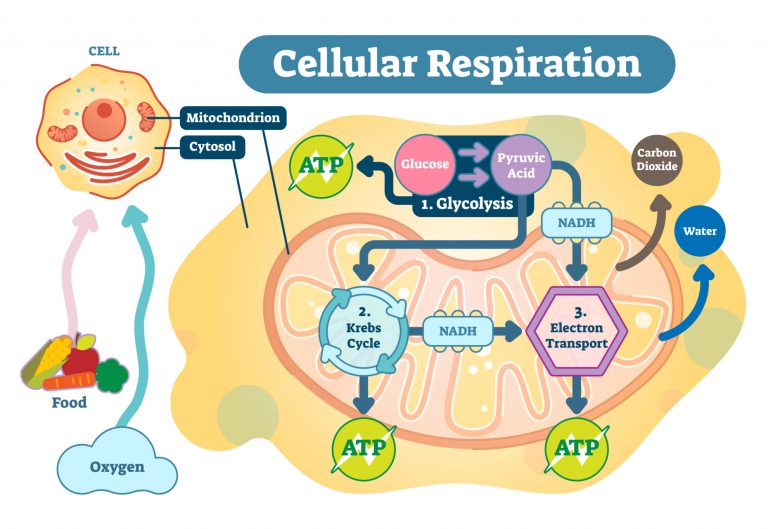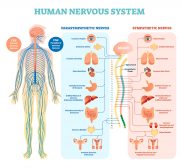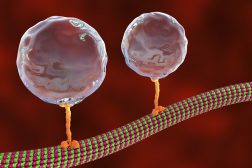Cell Respiration

Steps of cell respiration
Table of Contents
As mentioned in the previous tutorial on ATP, the process of respiration is split into 3 distinct areas that occur at different parts of the cell. Respiration involves the oxidation of foodstuff (i.e. glucose) in order to create ATP.
Respiration can occur with or without oxygen, aerobic and anaerobic respiration respectively.
Glycolysis
Glycolysis occurs in the cytoplasm of a cell where a 6 carbon glucose molecule (the broken down food that you ate earlier) is broken down by enzymes into a 3 carbon pyruvic acid.
The execution of this process requires 2 ATP and produces a net gain of 2 ATP.
The enzymes involved remove hydrogen from the glucose (oxidation) where they take these hydrogen atoms to the cytochrome system, explained soon.
In anaerobic respiration, this is where the process ends, glucose is split into 2 molecules of pyruvic acid. When oxygen is present, pyruvic is broken down into other carbon compounds in the Kreb’s Cycle. When it is not present, the pyruvic acid is broken down into lactic acid (or carbon dioxide and ethanol).
The Kreb’s Cycle
When oxygen is present, respiration can harness more ATP from a single unit of glucose. The pyruvic acid from the glycolysis stage diffuses into a cell organelle called a mitochondrion (pl. mitochondria). These mitochondria are sausage-shaped structures that host a large surface area for respiration to occur on.
The pyruvic acid is then subject to more enzymes that break it down into a 2 carbon compound, as seen below. The diagram illustrates the Kreb’s cycle, consisting of three main actions
- The carbon element is in an infinite cycle where the 2 carbon compound derived from pyruvic acid binds with the 4 carbon compound that is always present in the cycle.
- CO2 is released, where the oxygen that is present in aerobic respiration combines with carbon from the carbon compounds which is released as CO2. Hence the need for animals to breathe out and expel this CO2.
- Enzymes oxidize the carbon compounds and transport the hydrogen atoms to the cytochrome system.

The Cytochrome System
The cytochrome system, also known as the hydrogen carrier system (or the electron transport system) are where the reduced hydrogen carriers transport hydrogen atoms from the glycolysis and Kreb’s cycle stages. The cytochrome system is found in the many cristae of mitochondria, which are tiny stalked particles found on its outer layer.
The system contains many ‘hydrogen acceptors’ which hydrogen can be added to. By following the path of a hydrogen atom, we can see how the cytochrome system works:
- Some coenzymes from earlier stages (we shall call these A) are transferred to the next coenzymes (refer to them as B).
- B is then oxidized, therefore the coenzyme releases the hydrogen and energy is made available.
- The released hydrogen atom binds with 2 oxygen atoms (oxygen is available in aerobic respiration) which produces water, a by-product of respiration.
The diagram illustrates this flow of hydrogen within the cytochrome system and how energy is made available by the flow of these atoms. The green circles illustrate where energy is made available via oxidation.

Overall there is a gain of 38 ATP from one molecule of glucose in aerobic respiration. The food that we eat provides glucose required in respiration. In plants, energy is also acquired via respiration, but the mechanism of delivering glucose to the respiration process is a little different.
Photosynthesis is the process that plants undertake to create organic materials from carbon dioxide and water, with the help of sunlight- all of which are investigated in the next tutorial.
Credit: Amoeba Sisters
You will also like...

Fruits, Flowers, and Seeds
This tutorial deals with the structure and function of flowers, fruits, and seeds. Also included here are the types of f..

The Human Nervous System
The nervous system is essentially a biological information highway. This tutorial gives an overview of the nervous syste..

Adaptive Radiation
The diversification of several new species from a recent ancestral source, each adapted to utilize or occupy a vacant ad..

Movement of Molecules Across Cell Membranes
Molecules move within the cell or from one cell to another through different strategies. Transport may be in the form of..

Roots
This study guide tackles plant roots in greater detail. It delves into the development of plant roots, the root structur..

Cell Structure
A typical eukaryotic cell is comprised of cytoplasm with different organelles, such as nucleus, endoplasmic reticulum, G..
